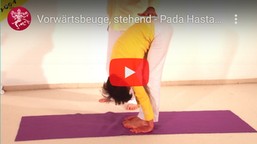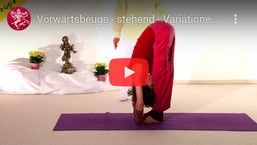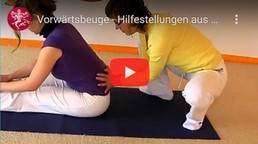

Padahastasana — Standing Forward Bend
«Padahastasana» means «Standing Forward Bend». «Padahastasana» is an Asana (Yoga Posture) from Hatha Yoga, which is one of the most important 84 Main Asanas. «Padahastasana» is the 11th Asana of the 12 Basic Postures of the Yoga Vidya Series in Hatha Yoga. Just like «Paschimottanasana», the «Seated Forward Bend», «Padahastasana» helps to develop devotion and patience and is similar to the «Inversion Postures» in some effects. «Padahastasana» stretches the entire backside of the body. In the Yoga Vidya series, «Padahastasana» is practiced after the balance exercises of the «Peacock» («Mayurasana») and the «Crow» («Kakasana»). After «Padahastasana» follows «Trikonasana», the «Triangle». If there are back problems, such as sciatica or a slipped disc, the «Forward Bends» should generally be done with caution. You may want to omit «Padahastasana» or switch to a gentle variation.
Table of Contents
1 Instruction and Exercise Videos for Padahastasana/a>
1.1 Standard Instructions
1.2 Standing Forward Bend Exercise Video — Practical Instruction
1.3 Standing Forward Bend Exercise Video — Variations by Difficulty Level
2.1.1 Stretched Muscles
2.2 Mentally
2.3 Energetically
2.3.1 Chakras Addressed
3 Swami Sivananda explains Padahastasana as follows in his book Yoga Asanas
Instruction and Exercise Videos for Padahastasana
Instructions Standard
- Stand upright in «Tadasana», the «Mountain Posture». Let the hands hang loosely and close to the sides of the body. Keep the heels closed while the toes are apart.
- With the next inhalation, raise the arms far up and with the next exhalation, slowly bend you far down until the fingertips or hands come completely to the ground without the elbows buckling. Keep the knees straight and pushed through while do so. Do not buckle at the knees. If you are unable to do this, you can also bend your knees slightly to place your hands flat next to your feet.
- Exhale slowly as you bend down, thereby pulling your belly backward. Keep your forehead between your knees. The face will be in the hollow that forms at the knees, or the head can be also pushed further between the thighs. Keep the neck and shoulders relaxed while do so.
- Hold «Padahastasana» for about 2 to 10 seconds, a few breaths, minutes or as long as it is relaxing for you. Untrained people will have some difficulty at first. With patience and perseverance, you will be able to practice the position perfectly. When you bend your back up again, you should tense your abdominal and gluteal muscles while doing so.
- To dissolve «Padahastasana», you can come back up powerfully with your back straightened or gently straighten your back, vertebra by vertebra, until you are back in the starting position. Now trace the effect of «Padahastasana».
Standing Forward Bend Exercise Video — Practical Instruction
Here Sukadev instructs you to the Yoga Exercise of the «Standing Forward Bend» and shows you how to optimally perform the «Standing Forward Bend». This is an excerpt from the first course video of the 10-week Beginners Course.

 |
 |
Standing Forward Bend Exercise Video — Variations by Difficulty Level
The Yoga Exercise «Standing Forward Bend» from a Yoga Session: Sukadev instructs you to the «Standing Forward Bend» in different difficulty levels or variations and shows you how to perform these exercises optimally.
This is an excerpt from the ninth course video of the 10-week Beginners Course.

 |
 |
Effects of Padahastasana
Physically
«Padahastasana» has some of the same effects as «Paschimotthanasana», the «Forward Bend». «Padahastasana» keeps the waist slim, restores elasticity of the spine, and stretches the tendons in the legs, especially in the back of the knees. It also supports blood flow to the brain and has some of the effects of the «Inversion Postures».
Stretched Muscles
- Gastrocnemius (calf muscles)
- Bizeps Femoris (leg flexors)
- Gluteus (gluteal muscles)
- Longissimus (back extensors)
Mentally
«Padahastasana» helps to develop humility and devotion.
Energetically
«Padahastasana» has an invigorating and energizing effect.
Chakras Addressed
The following Chakras are most commonly addressed:
- Sahasrara
- Muladhara
Contra-Indications
In case of certain back complaints, such as sciatica, herniated discs, etc., the «Forward Bends» should be done with caution. Eventually omit this Asana or switch to a gentle variation.
Swami Sivananda explains Padahastasana as follows in his book Yoga Asanas
The Hand — Foot Position
This posture can be called «Standing Paschimottanasana», «Standing Forward Bend», because the technique itself is the same. The only difference is that it is practiced while standing. It is also sometimes called «Hastapadangasana», Hand — Foot Posture.
Benefits
This Asana offers multiple benefits. After completing the exercise, you will feel you very strengthened. The body becomes light as much «Tamas» is reduced. Obesity disappears. Shortening of the legs due to fractures or broken thighs will be equaled. A slight stretching of the legs is achieved by performing the exercise for about three months, and thereby the legs or thighs rubbing with mustard oil to which a little salt has been added. The salt allows the oil to penetrate more easily. This Asana increases the flow of energy downward. The «Sushumna» would be purified and strengthened. The benefit of «Paschimottanasana» are also achieved in this Asana.
Variations
- Padahastasana (second variation): Stand upright. Slowly raise your left leg and grasp the big toe with your fingers. Hold the right hand at the hips. Keep the legs pressed through. This variation is often called «Padahastasana» (Hand — Foot Posture).
- Tadasana (Mountain Posture): Students know this pose from physical education classes. Now raise one hand very quickly above the head. Thereby the head should not be bent. Then bring it back to the starting position. Now do the same movement with the other hand. Repeat this sequence as many times as possible. Instead of placing the hand over the head in one movement, you can also stop for a moment when the hand reaches shoulder level and keep it parallel to the ground. You can also bring both hands together. When you are done with the Asana, massage the muscles of the hand, shoulders, etc. This exercise is also called «Vrikshasana» , the «Tree Posture». «Sirshasana» is also called «Vrikshasana». Stand upright on one leg while holding the other leg at the bottom of the thigh. This is another variation of «Vrikshasana».
- Utthita Vivekasana: This position is very useful for standing «Pranayama» and «Japa». Stand upright. You can thereby keep your hands folded in front of your chest.
- Purnapadasana: If you stand upright with your hands at your sides, this is called «Purnapadasana».
Video on Padahastasana

 |
 |

